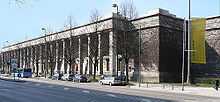Paul Troost

Paul Ludwig Troost (17 August 1878 – 21 January 1934),[1][2] born in Elberfeld, was a German architect. An extremely tall, spare-looking, reserved Westphalian with a close-shaven head, Troost belonged to a school of architects, Peter Behrens and Walter Gropius who, even before 1914, reacted sharply against the highly ornamental Jugendstil and advocated a restrained, lean architectural approach, almost devoid of ornament. Troost graduated from designing steamship décor before World War I, and the fittings for showy transatlantic liners like the Europa, to a style that combined Spartan traditionalism with elements of modernity.

Hitler
Although, before 1933 he did not belong to the leading group of German architects, he became Hitler's foremost architect whose neo-classical style became for a time the official architecture of the Third Reich. His work filled Hitler with enthusiasm, and he planned and built state and municipal edifices throughout Germany.
In the autumn of 1933, he was commissioned to rebuild and refurnish the Chancellery residence in Berlin.[3] Along with other architects, Troost planned and built State and municipal edifices throughout the country, including new administrative offices, social buildings for workers and bridges across the main highways. One of the many structures he planned before his death was the House of German Art in Munich,[4] intended to be a great temple for a "true, eternal art of the German people". It was a good example of the imitation of classical forms in monumental public buildings during the Third Reich, though subsequently Hitler moved away from the more restrained style of Troost, reverting to the more elaborate imperial grandeur that he had admired in the Vienna Ringstraße of his youth.
Hitler's relationship to Troost was that of a pupil to an admired teacher. According to Albert Speer, who later became Hitler's favorite architect, the Führer would impatiently greet Troost with the words: "I can't wait, Herr Professor. Is there anything new? Let's see it!" Troost would then lay out his latest plans and sketches. Hitler frequently declared, according to Speer, that "he first learned what architecture was from Troost"'. The architect's death on 21 January 1934, after a severe illness, was a painful blow, but Hitler remained close to his widow Gerdy Troost, whose architectural taste frequently coincided with his own, which made her (in Speer's words) "a kind of arbiter of art in Munich." He was buried in the "Nordfriedhof" Cemetery (North Cemetery) in Munich. The gravestone still survives although the family name has been removed.
Hitler posthumously awarded Troost the German National Prize for Art and Science in 1936.
See also
References
- ↑ Albert Speer, Inside the Third Reich (Simon and Schuster, 1970) p49
- ↑ Sven Felix Kellerhoff, The Führer Bunker: Hitler's Last Refuge (Berlin Story Verlag, 2004) p38
- ↑ Seligmann, Matthew; Davison, John; and McDonald, John (2003). Daily Life in Hitler's Germany, p. 96. London: The Brown Reference Group plc. ISBN 0-312-32811-7.
- ↑ Zalampas, Sherree Owens (1990). Adolf Hitler: A Psychological Interpretation of His Views on Architecture, Art and Music, p. 76. Bowling Green State University Popular Press. ISBN 0-87972-488-9.
|